CyberTAN Technology WE701I IEEE 802.11a/b/g Wireless Lan CardBus User Manual WE701 I User s Manual 01 XP draft
CyberTAN Technology Inc. IEEE 802.11a/b/g Wireless Lan CardBus WE701 I User s Manual 01 XP draft
Contents
- 1. Manual
- 2. Users Manual Revised
Manual
11a/g Wireless
LAN CardBus
Card
User’s Manual
Rev 0.1

54M Wireless LAN CardBus Card User’s Manual
2
Federal Communication Commission Interference Statement
This equipment has been tested and found to comply with the limits for a Class B
digital device, pursuant to Part 15 of the FCC Rules. These limits are designed to
provide reasonable protection against harmful interference in a residential installation.
This equipment generates, uses and can radiate radio frequency energy and, if not
installed and used in accordance with the instructions, may cause harmful interference
to radio communications. However, there is no guarantee that interference will not
occur in a particular installation. If this equipment does cause harmful interference to
radio or television reception, which can be determined by turning the equipment off and
on, the user is encouraged to try to correct the interference by one of the following
measures:
- Reorient or relocate the receiving antenna.
- Increase the separation between the equipment and receiver.
- Connect the equipment into an outlet on a circuit different from that
to which the receiver is connected.
- Consult the dealer or an experienced radio/TV technician for help.
FCC Caution: Any changes or modifications not expressly approved by the party
responsible for compliance could void the user's authority to operate this equipment.
This device complies with Part 15 of the FCC Rules. Operation is subject to the
following two conditions: (1) This device may not cause harmful interference, and (2)
this device must accept any interference received, including interference that may cause
undesired operation.
IMPORTANT NOTE:
FCC Radiation Exposure Statement:
This equipment complies with FCC radiation exposure limits set forth for an uncontrolled
environment.
This device is intended only for OEM integrators under the following conditions:
1) The antenna should be integral if the end device is intended to be operated in 5.15 ~
5.25GHz frequency range.
As long as 1 condition above are met, further transmitter test will not be required. However, the
OEM integrator is still responsible for testing their end-product for any additional compliance
requirements required with this module installed (for example, digital device emissions, PC
peripheral requirements, etc.).
IMPORTANT NOTE: In the event that these conditions can not be met (for example certain
laptop configurations or co-location with another transmitter), then the FCC authorization is no
longer considered valid and the FCC ID can not be used on the final product. In these
circumstances, the OEM integrator will be responsible for re-evaluating the end product
(including the transmitter) and obtaining a separate FCC authorization.
End Product Labeling
The final end product must be labeled in a visible area with the following: “Contains TX FCC ID:
N89-WE701I”.

54M Wireless LAN CardBus Card User’s Manual
3
Manual Information That Must be Included
The OEM integrator has to be aware not to provide information to the end user regarding how to install
or remove this RF module in the users manual of the end product which integrate this module.
The users manual for OEM integrators end users must include the following information in a prominent
location “ IMPORTANT NOTE: To comply with FCC RF exposure compliance requirements. The
antenna must not be co-located or operating in conjunction with any other antenna or transmitter”.
If the end product integrating this module is going to be operated in 5.15 ~ 5.25GHz frequency range,
the warning statement in the user manual of the end product should include the restriction of operating
this device in indoor could void the user’s authority to operate the equipment.
The equipment version marketed in US is restricted to usage of the channels 1-11 only
About this manual
This User’s Manual describes how to install and operate your CardBus Wireless
LAN Card. Please read this manual before you install the product.
This manual includes the following topics:
Ø Product description and features.
Ø Hardware installation procedure.
Ø Software installation procedure.
Ø FAQ

54M Wireless LAN CardBus Card User’s Manual
4
Table of Contents
Regulatory compliance..................................................................................2
About this manual..........................................................................................3
Chapter 1 - Introduction.................................................1
Features ..................................................................................................1
What is Wireless LAN?...........................................................................2
Wireless LAN Modes ..............................................................................2
Notes on Wireless LAN Configuration ...................................................3
Chapter 2 - Hardware Installation...................................4
Package Contents...................................................................................4
System Requirements for the Adapter...................................................4
Hardware description..............................................................................4
Inserting the Wireless LAN Card............................................................4
LED Indicators.........................................................................................5
Ejecting the Wireless LAN card..............................................................5
Chapter 3 – Driver Installation for Windows ....................7
Driver installation for Windows XP.........................................................7
Chapter 4 – Installing and Using the Wireless Utility.....10
Installation in Windows ........................................................................ 10
Using Wireless Utility In Windows XP................................................. 13
Use Windows Wireless Network Configuration..........................................13
Use Wireless LAN Utility................................................................................16
Configuring the CardBus Wireless LAN Card..................................... 19
Chapter 1 - Introduction
Thank you for purchasing the CardBus Wireless LAN Card. This high-speed
CardBus Wireless LAN Card provides you with an innovative wireless networking
solution. The Adapter is easy to set up and use. With this innovative wireless
technology, you can share files and printers on the network—without inconvenient
wires!
The Adapter is a network Adapter with a rate of 1, 2, 5.5, 6, 9, 11, 12, 24, 36, 48
and 54 Mbps operating in the IS M band using Direct Sequence Spread Spectrum
(DSSS) transmission implementing the IEEE 802.11a/g draft standard. This
Adapter provides Device Drivers for Windows Operating Systems. It also provides
tools for the configuration of the Adapter. The tool, as well as the installation
steps of the plug-and-play procedure for the Windows operating systems, is
described in this document.
Features
The CardBus Wireless LAN Card offers compliance with the IEEE 802.11a/g draft
specification. This feature allows them to communicate with other wireless
devices that support the standard. Features of the Adapter are:
l Uses 2.4GHz and 5GHz frequency band, which complies with worldwide
requirement
l Wireless interface following the IEEE 802.11a/g standard
l Using CardBus interface
l Security support WPA
l Wire-free access to networked resources from anywhere beyond the
notebook
l Allows users move between Access Points without resetting their
connection reconfiguration
l Delivers data rate up to 54 Mbps
l Supports 1, 2, 5.5, 6, 9, 11, 12, 24, 36, 48 and 54 Mbps rates
l Provide CardBus Wireless LAN Card Configuration utility
l The Adapter uses external Antenna with LEDs indicating Power and Link
l Supports most popular operating systems

54M Wireless LAN CardBus Card User’s Manual
2
What is Wireless LAN?
Wireless Local Area Network (WLAN) systems offer a great number of
advantages over traditional wired systems. WLAN is flexible and easy to setup
and manage. They are also more economical than wired LAN systems.
Using radio frequency (RF) technology, WLAN transmit and receive data through
the air. WLAN combine data connectivity with user mobility. For example, users
can roam from a conference room to their office without being disconnected from
the LAN.
Using WLAN, users can conveniently access-shared information, and network
administrators can configure and augment networks without installing or moving
network cables.
WLAN technology provides users with many convenient and cost saving features:
• Mobility: WLAN provide LAN users with access to real-time information
anywhere in their organization, providing service opportunities that are
impossible with wired networks.
• Ease of Installation: Installing is easy for novice and expert users alike,
eliminating the need to install network cables in walls and ceilings.
• Scalability: WLAN can be configured in a variety of topologies to adapt to
specific applications and installations. Configurations are easily changed
and range from peer-to-peer networks suitable for a small number of users
to full infrastructure networks of thousands of users roaming over a broad
area.
Wireless LAN Modes
Wireless LANs can be configured in one of two ways:
Ad-hoc
Networking Also known as a peer-to-peer network, an ad-hoc
network is one that allows all workstations and
computers in the network to act as servers to all other
users on the network. Users on the network can share
files, print to a shared printer, and access the Internet
with a shared modem. However, with ad-hoc
networking, users can only communicate with other
wireless LAN computers that are in the wireless LAN
workgroup, and are within range.
Infrastructure
Networking Infrastructure networking differs from ad-hoc
networking in that it includes an access point. Unlike
the ad-hoc structure where users on the LAN contend
the shared bandwidth, on an infrastructure network the
access point can manage the bandwidth to maximize
bandwidth utilization.

54M Wireless LAN CardBus Card User’s Manual
3
Additionally, the access point enables users on a
wireless LAN to access an existing wired network,
allowing wireless users to take advantage of the wired
networks resources, such as Internet, email, file
transfer, and printer sharing.
Infrastructure networking has the following advantages
over ad-hoc networking:
• Extended range: each wireless LAN computer
within the range of the access point can
communicate with other wireless LAN computers
within range of the access point.
• Roaming: the access point enables a wireless
LAN computer to move through a building and still
be connected to the LAN.
• Wired to wireless LAN connectivity: the access
point bridges the gap between wireless LANs and
their wired counterparts.
Notes on Wireless LAN Configuration
When configuring a wireless LAN (WLAN), be sure to note the following points:
• Optimize the performance of the WLAN by ensuring that the distance
between access points is not too far. In most buildings, WLAN Adapters
operate within a range of 100 ~ 300 feet, depending on the thickness and
structure of the walls.
• Radio waves can pass through walls and glass but not metal. If there is
interference in transmitting through a wall, it may be that the wall has
reinforcing metal in its structure. Install another access point to circumvent
this problem.
• Floors usually have metal girders and metal reinforcing struts that interfere
with WLAN transmission.
This concludes the first chapter. The next chapter deals with the hardware
installation of the Adapter.
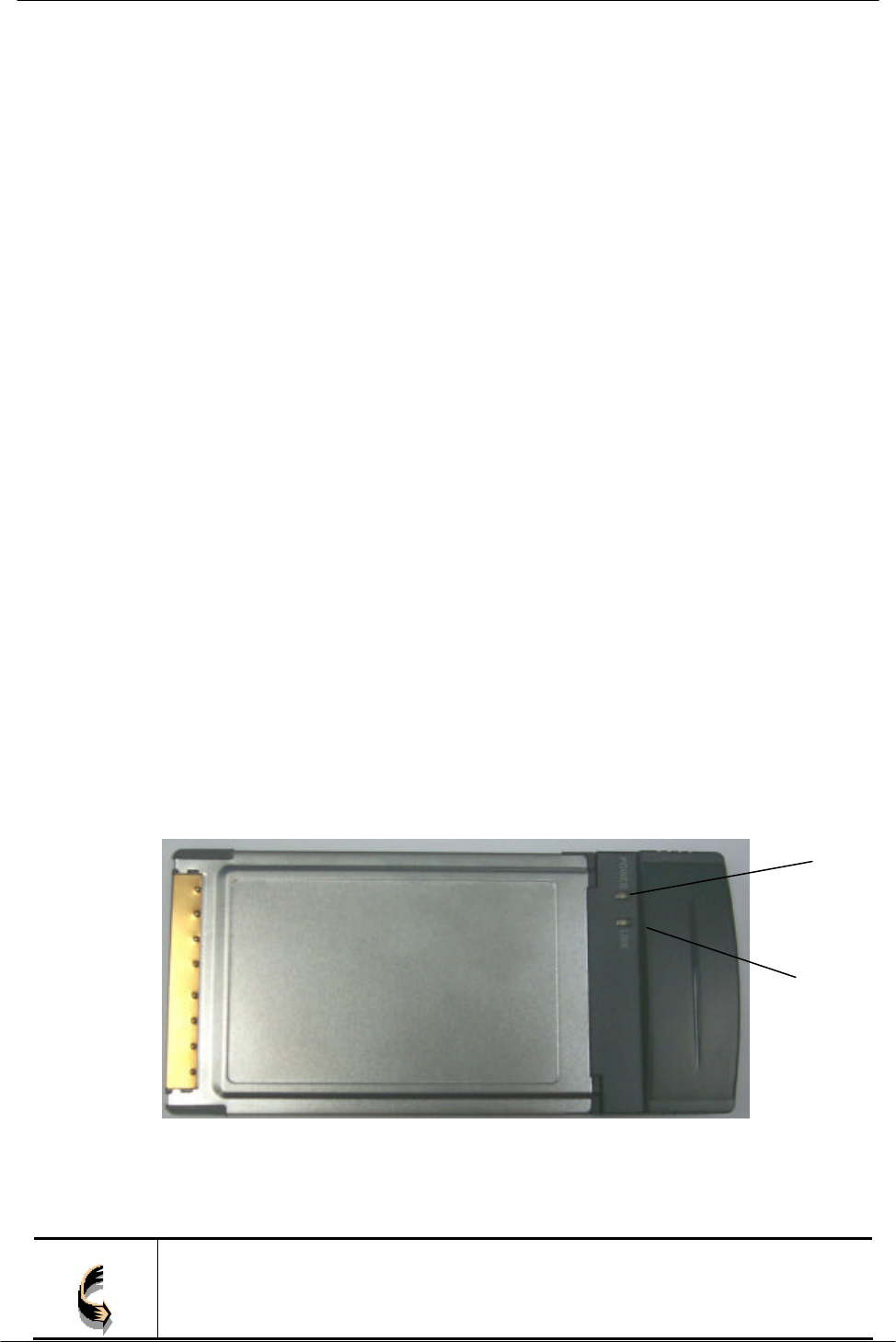
54M Wireless LAN CardBus Card User’s Manual
4
Chapter 2 - Hardware Installation
This chapter covers connecting your CardBus Wireless LAN Card to CardBus slot
of notebook.
Package Contents
Please make sure that items below are included on package.
ü One CardBus Wireless LAN Card
ü One CD containing drivers and documentation
ü One Quick Installation Guide
System Requirements for the Adapter
Ø Operating System: Microsoft Windows 98/ME/2000/XP
Ø Notebook with CD-ROM drive
Ø One free CardBus slot
Ø Pentium-Class 90MHz or higher
Hardware description
The Wireless LAN Card is encased in a stainless compact frame and has a 68-pin
connector for attaching to the CardBus port of notebook.
Inserting the Wireless LAN Card
Note!
These instructions apply to most notebook computers. For detailed
information on inserting PC cards into your notebook, consult the
notebook manual.
POWER
LINK
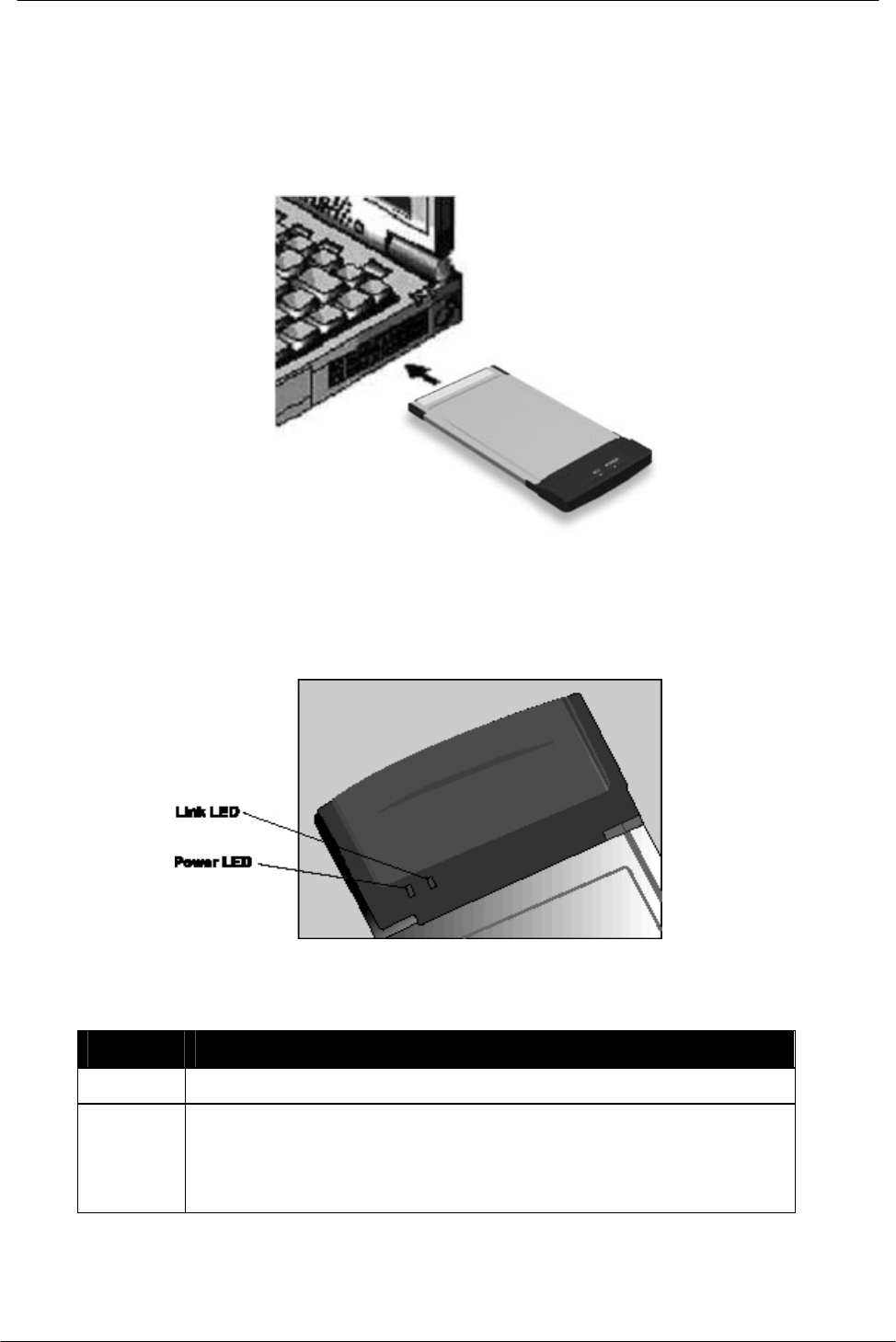
54M Wireless LAN CardBus Card User’s Manual
5
Follow the procedure below to install the Wireless LAN card.
1. With 68-pin connector of the card facing the CardBus slots on notebook,
slide the card all the way into an empty slot.
2. Connect to a network.
LED Indicators
The following table describes the meaning of LED indicators:
LED MEANING
POWER
Indicates that the Adapter is powered on (solid green).
LINK
Indicates link status. It is normally blinking. When blinking,
indicates that the card is scanning the channels, and the link
is not active. When lit, indicates that the card is locked to a
channel, and the link is active.
Ejecting the Wireless LAN card
After disconnecting from the LAN, you can eject the Wireless LAN card from the PC

54M Wireless LAN CardBus Card User’s Manual
6
Card slot of notebook.
Note!
In Windows XP/2000/ME/98 operating systems, you do not have to
power down the notebook to remove the card. The card is
hot-swappable — you can remove the card when the notebook is
powered on. However, Microsoft recommends that you stop the card.
Refer to your Windows 2000/ME/98 online help for information on
stopping the Wireless LAN card.
Most notebooks have an eject lever or button for ejecting PC cards from the PC slots.
Consult your notebook manual for details.
Warning!
To prevent data loss, do not eject the Wireless LAN card
when a data transmission is taking place. Exit your
communications program normally, stop the card if
necessary, and then remove the card.
After hardware installation is completed, please go to Chapter 3 to install driver on
different Operating System.

54M Wireless LAN CardBus Card User’s Manual
7
Chapter 3 – Driver Installation for Windows
The following sections cover CardBus Wireless LAN Card driver installation in the
Windows Operating Systems.
Note!
You have to install your hardware first before you begin to install
the drivers.
Driver installation for Windows XP
Follow the steps below to install the CardBus Wireless LAN Card drivers for Windows
XP.
1. Insert the CardBus Wireless LAN Card to CardBus slot of notebook first. (Refer to
Chapter 2 – Hardware installation.)
2. After Windows XP detects the CardBus Wireless LAN Card, the Found New
Hardware Wizard window appears. Select Install the software automatically
[Recommended] and insert the driver CD-ROM into CD-ROM drive and click
Next to continue.
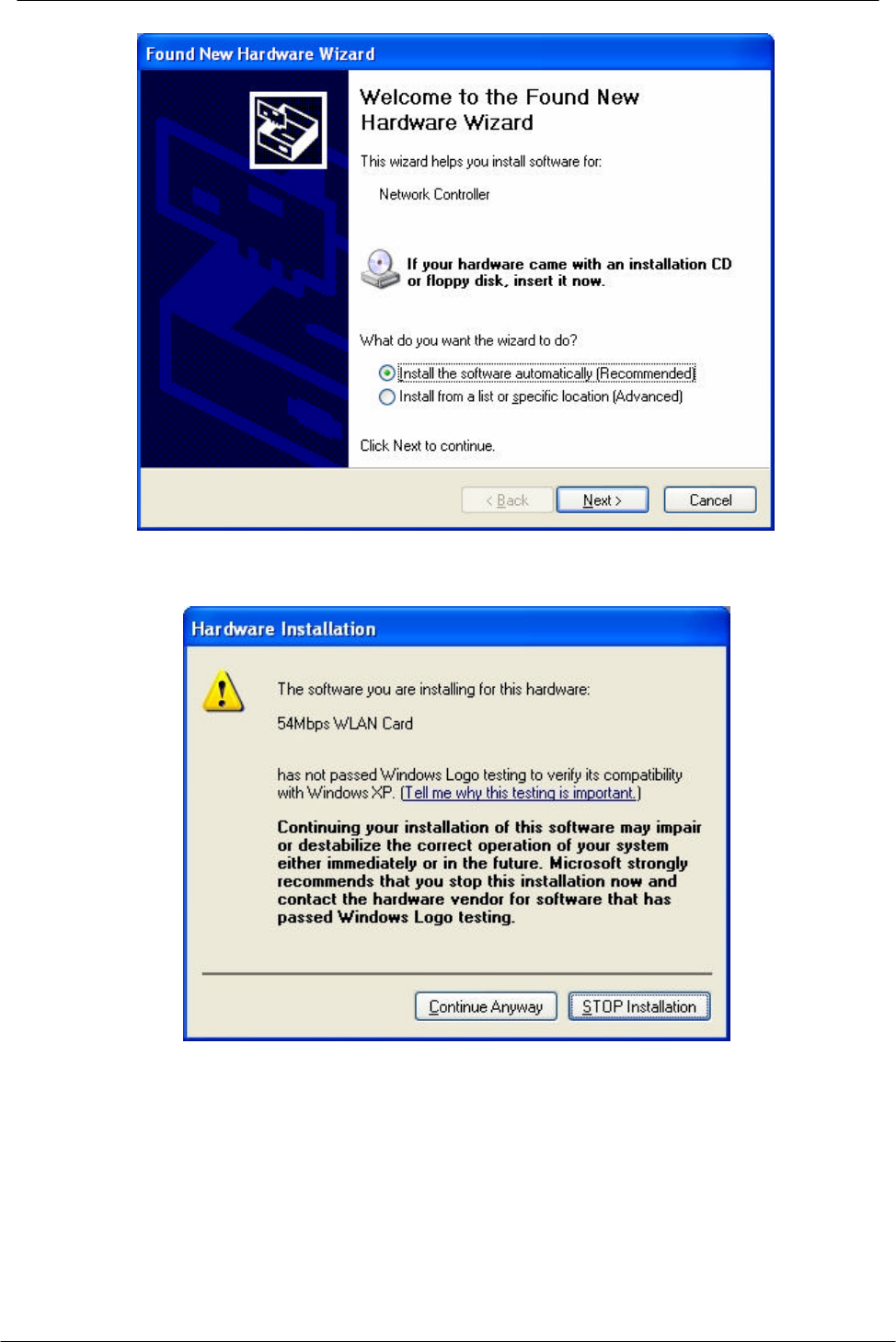
54M Wireless LAN CardBus Card User’s Manual
8
3. Click Continue Anyway to continue the installation.
4. The Windows has finished installing software for the device. Click Finish to finish
the installation
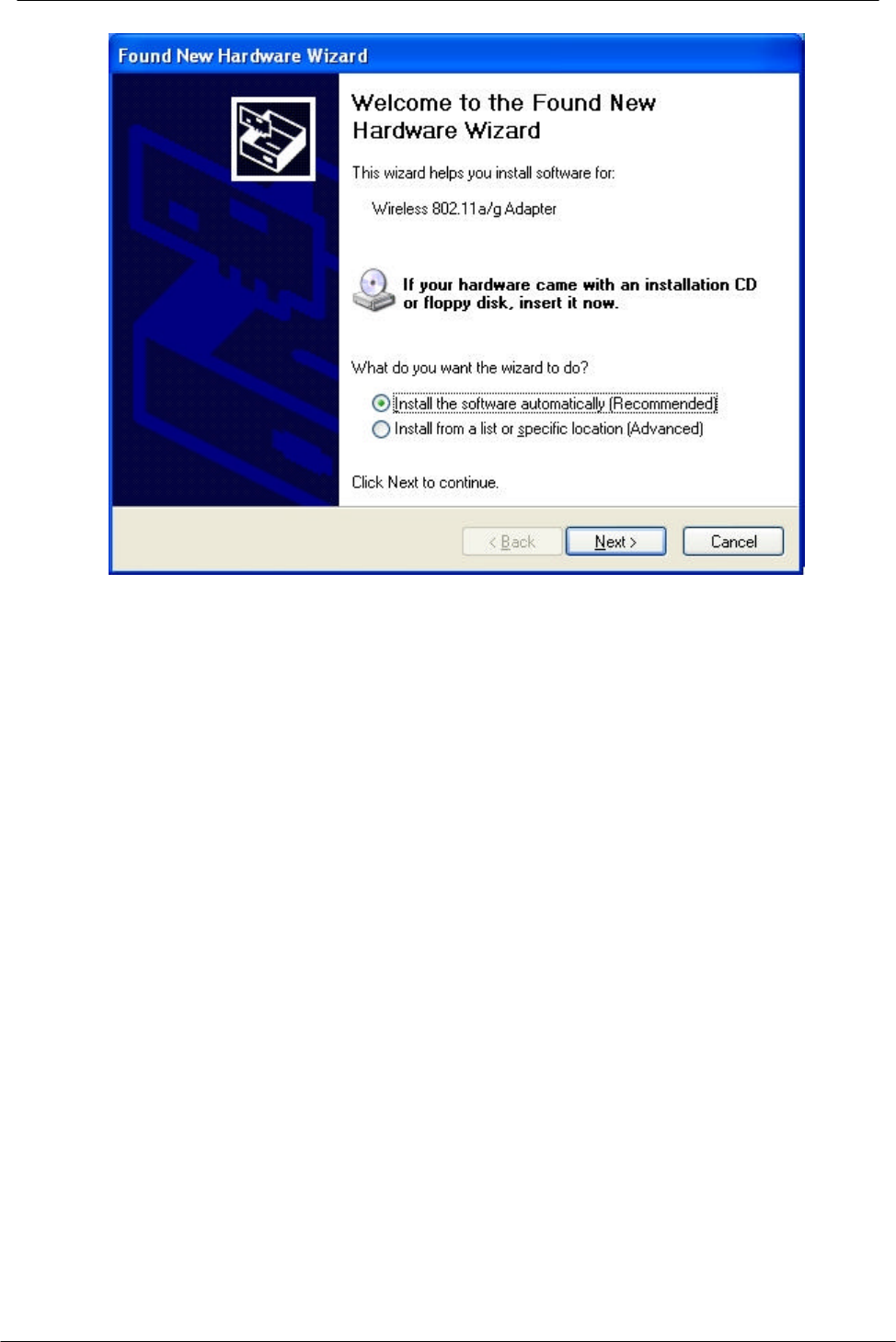
54M Wireless LAN CardBus Card User’s Manual
9
Then system will start to install Wireless utility automatically. Please refer to
procedures at Chapter 4.
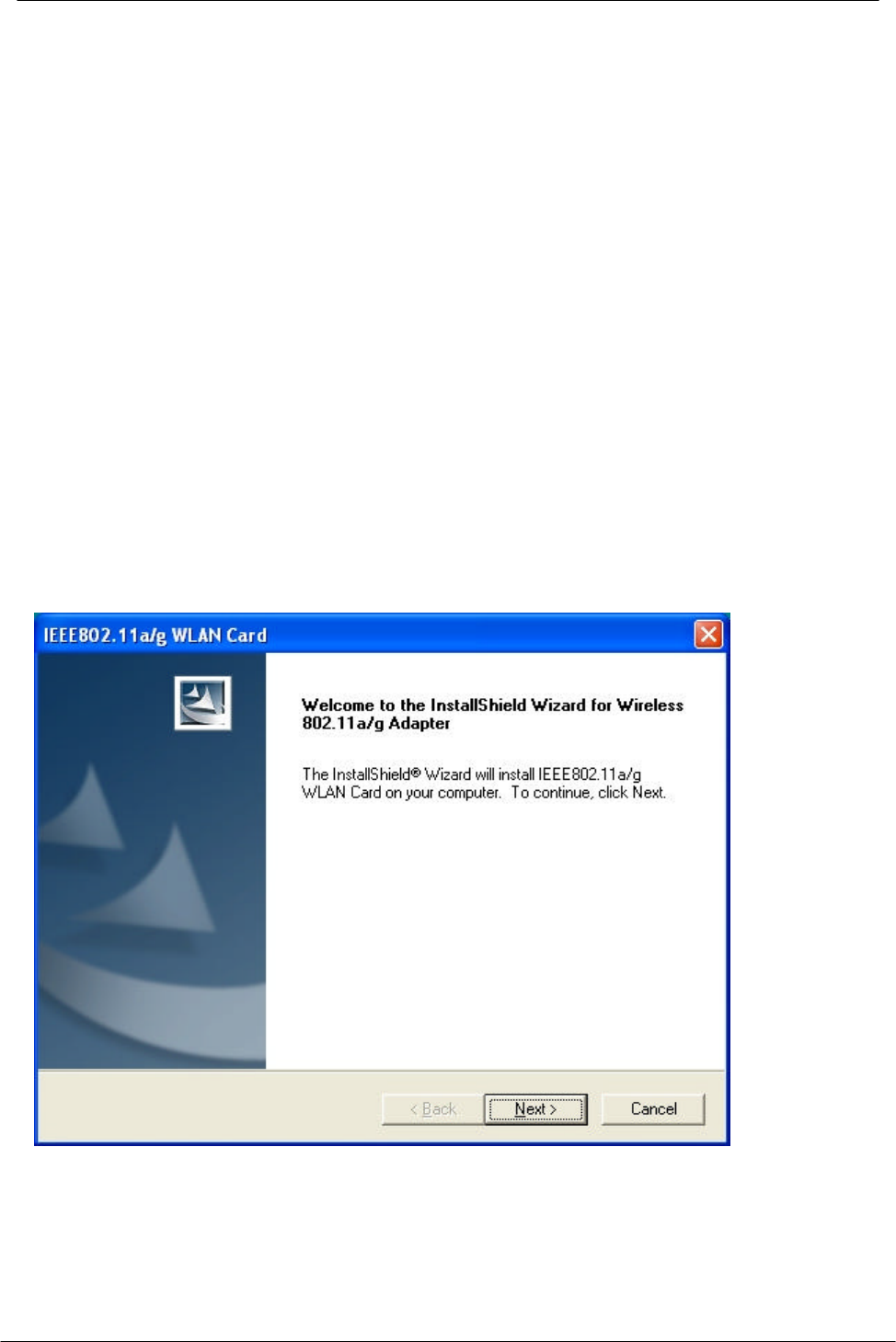
54M Wireless LAN CardBus Card User’s Manual
10
Chapter 4 – Installing and Using the
Wireless Utility
The following sections cover the CardBus Wireless LAN Card utility installation and
configuration.
Installation in Windows
After you have installed driver, system will start to install Wireless LAN Utility. Please
follow the steps below to install the utility.
1. Once you see the following screen, click Next to continue.
2. The screen will show you the default destination chosen by the utility. Click Next to
continue or click the Browse button to select an alternate destination.
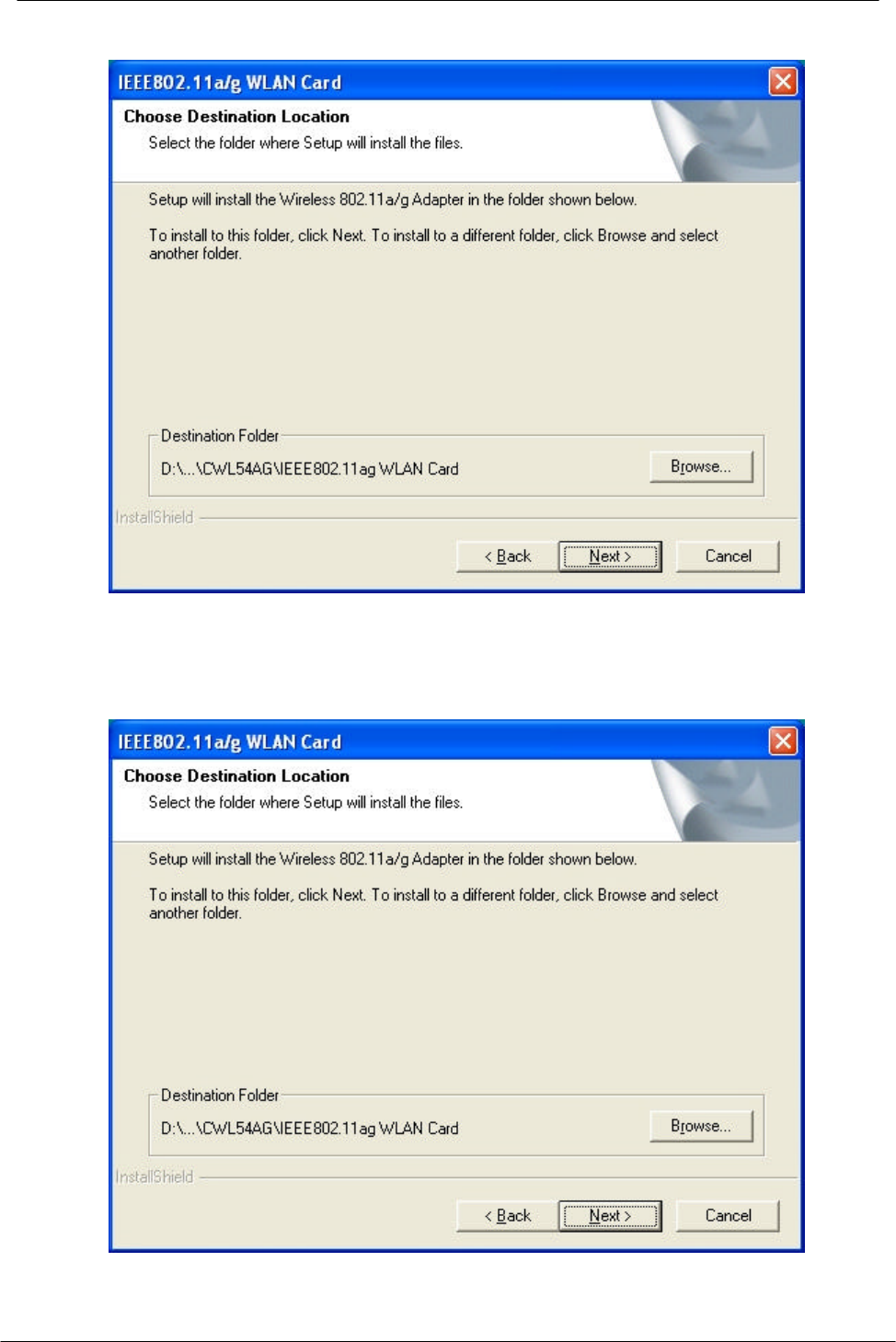
54M Wireless LAN CardBus Card User’s Manual
11
3. The following screen will add program icons to the Program Folder. You may type
a new folder name or select one from the existing folders list. Click Next to
continue or click Back to review or change any settings.
4. The following screen shows the current settings, click Next to continue or click
Back to change the Destination Folder in step 3.
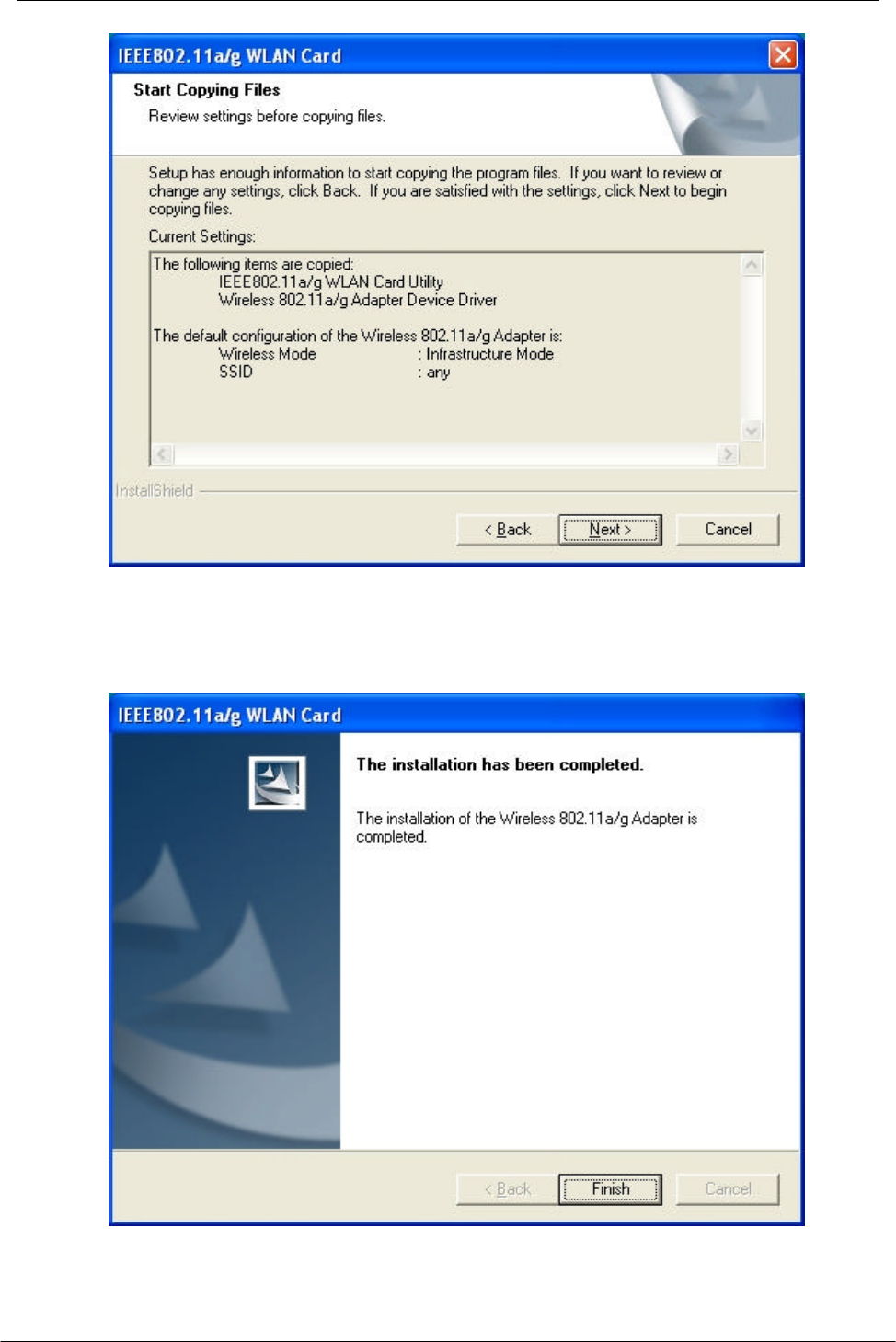
54M Wireless LAN CardBus Card User’s Manual
12
5. The Windows has finished installing Wireless LAN Utility. The following screen will
ask you to restart your computer to finish the installation. Click Finish to reboot the
system.
After you have installed the utility, you will see the Wireless LAN Utility icon in the
Windows taskbar:
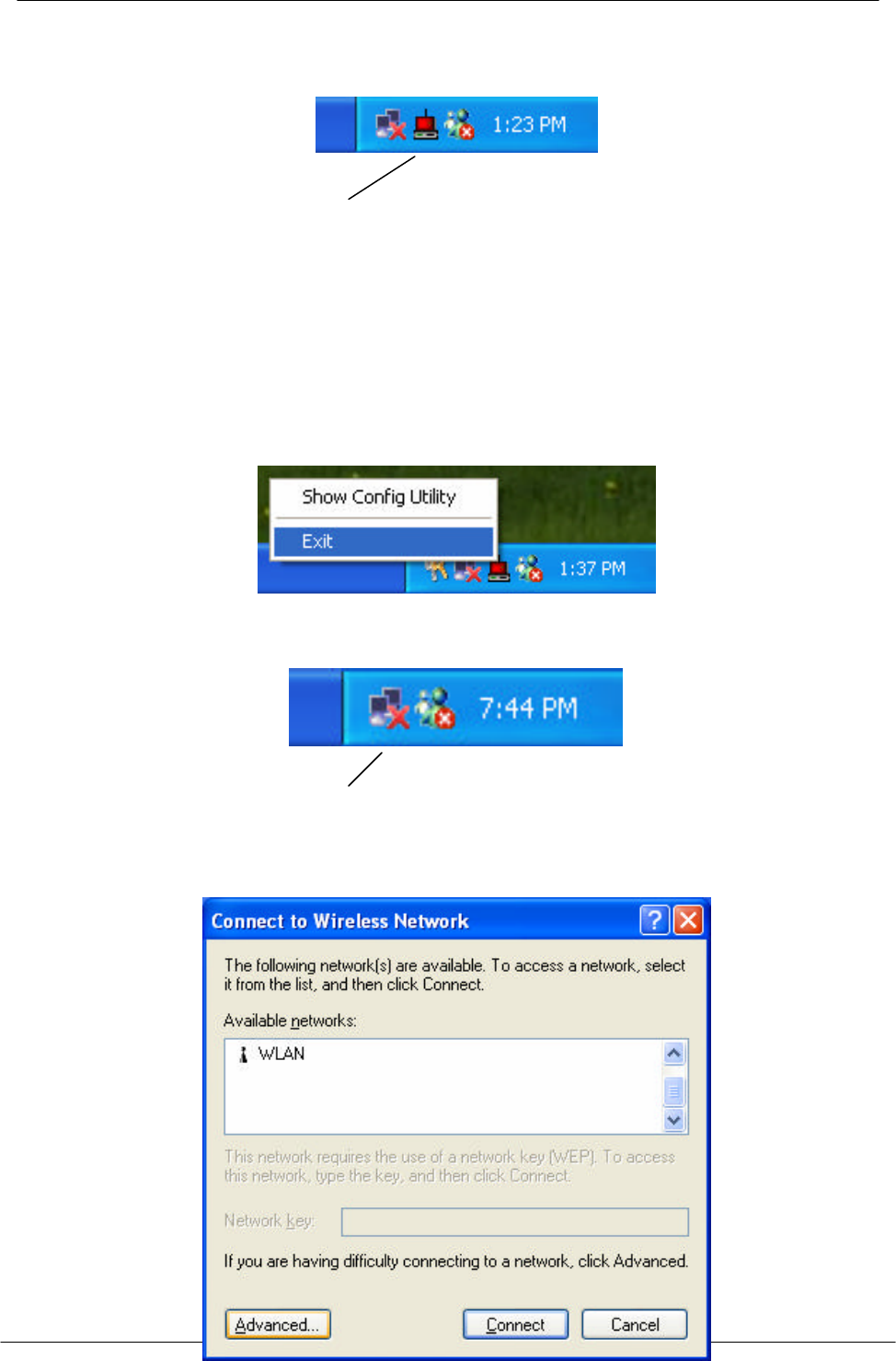
54M Wireless LAN CardBus Card User’s Manual
13
Using Wireless Utility In Windows XP
Wireless LAN Utility
There are two ways to configure CardBus Wireless LAN Card. One is Wireless LAN
Utility; the other one is Windows Wireless Network Configuration.
Use Windows Wireless Network Configuration
1. Click the right key of the mouse and Exit Wireless LAN Utility.
2. Click Windows Wireless Network Configuration icon.
Windows Wireless Network Configuration
3. Click Advanced… button.
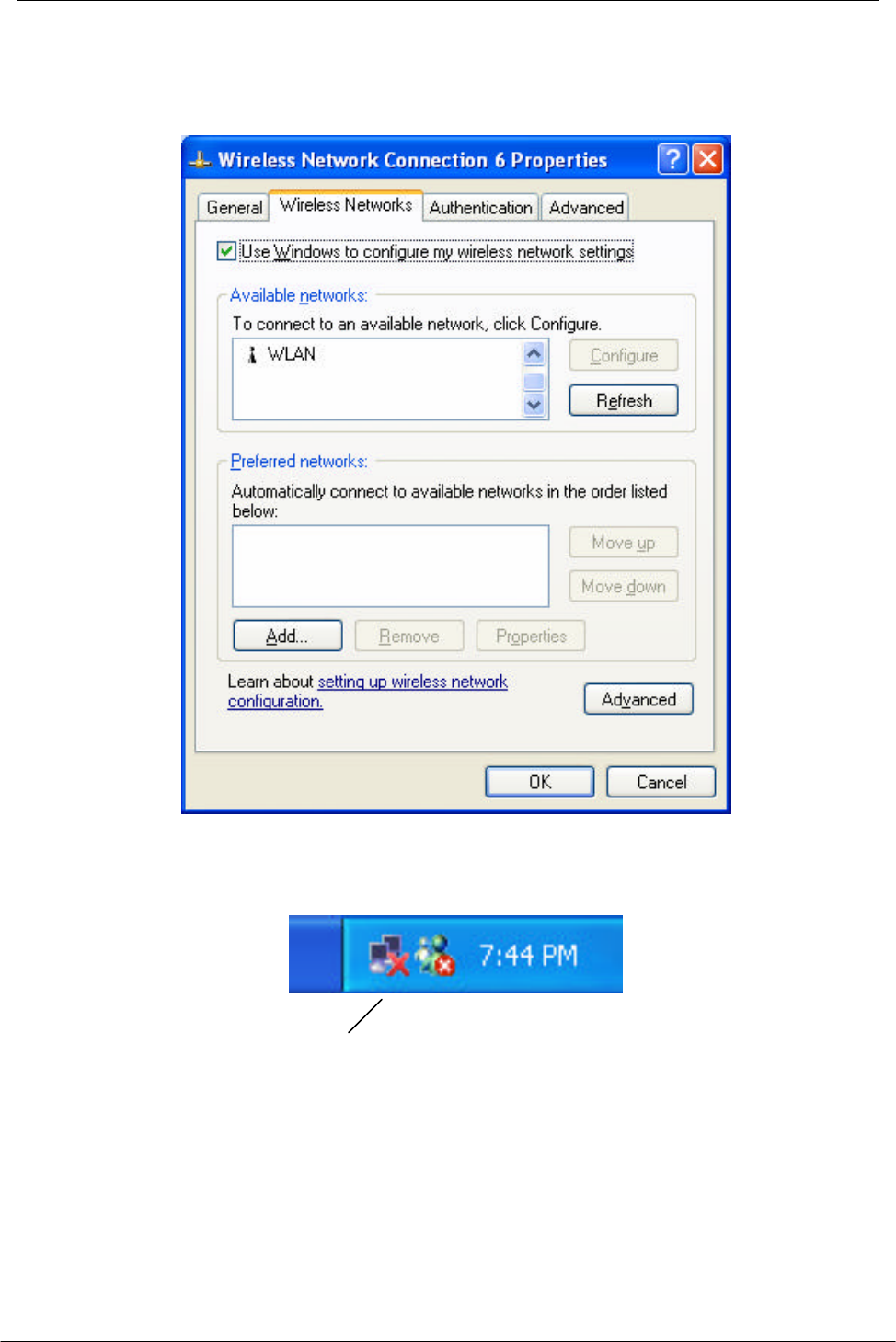
54M Wireless LAN CardBus Card User’s Manual
14
4. Make sure “Use Windows to configure my wireless network settings” is checked
and click OK.
5. Click the Windows Wireless Network Configuration icon again to open the
Windows Wireless Network Configuration.
Windows Wireless Network Configuration
6. Select an available network and click Connect button.
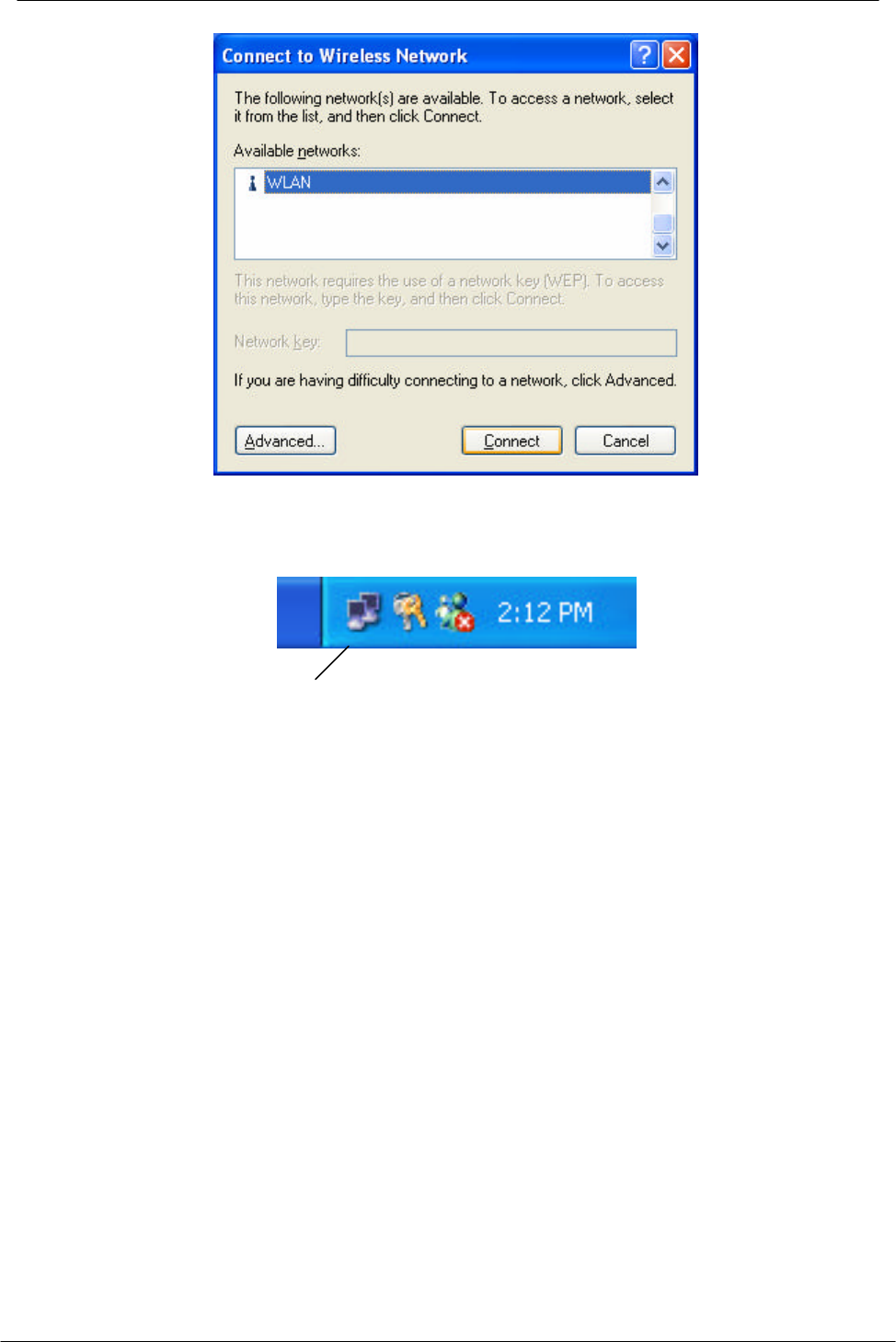
54M Wireless LAN CardBus Card User’s Manual
15
6. The Windows Wireless Network Configuration will be enabled. Click the Windows
Wireless Configure icon.
Windows Wireless Network Configuration is enabled
1. Click Properties to start Windows Wireless Network Configuration.
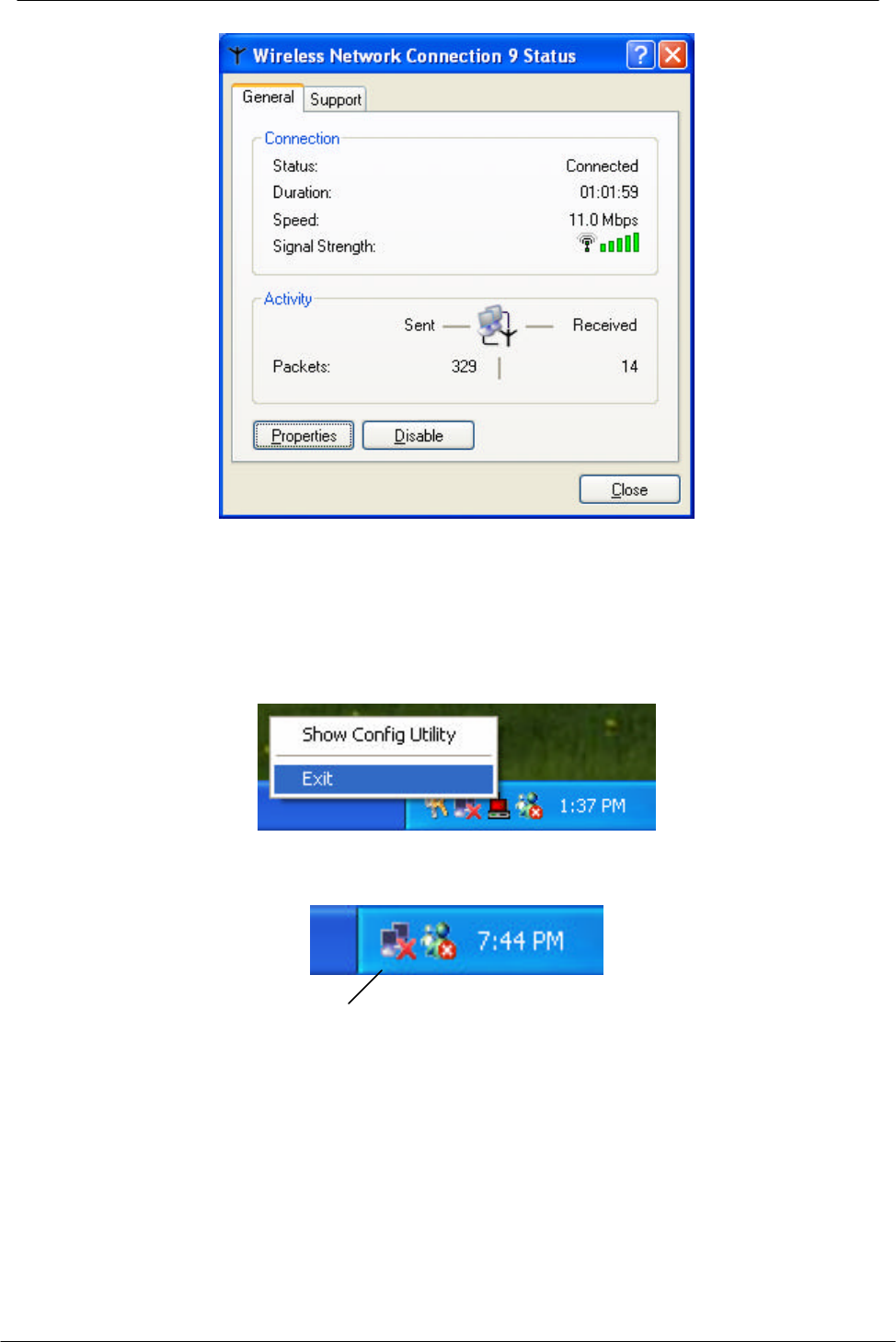
54M Wireless LAN CardBus Card User’s Manual
16
Use Wireless LAN Utility
1. Exit the Wireless LAN Utility.
2. Click Windows Wireless Network Configuration icon.
Windows Wireless Network Configuration
3. Click Advanced… button.
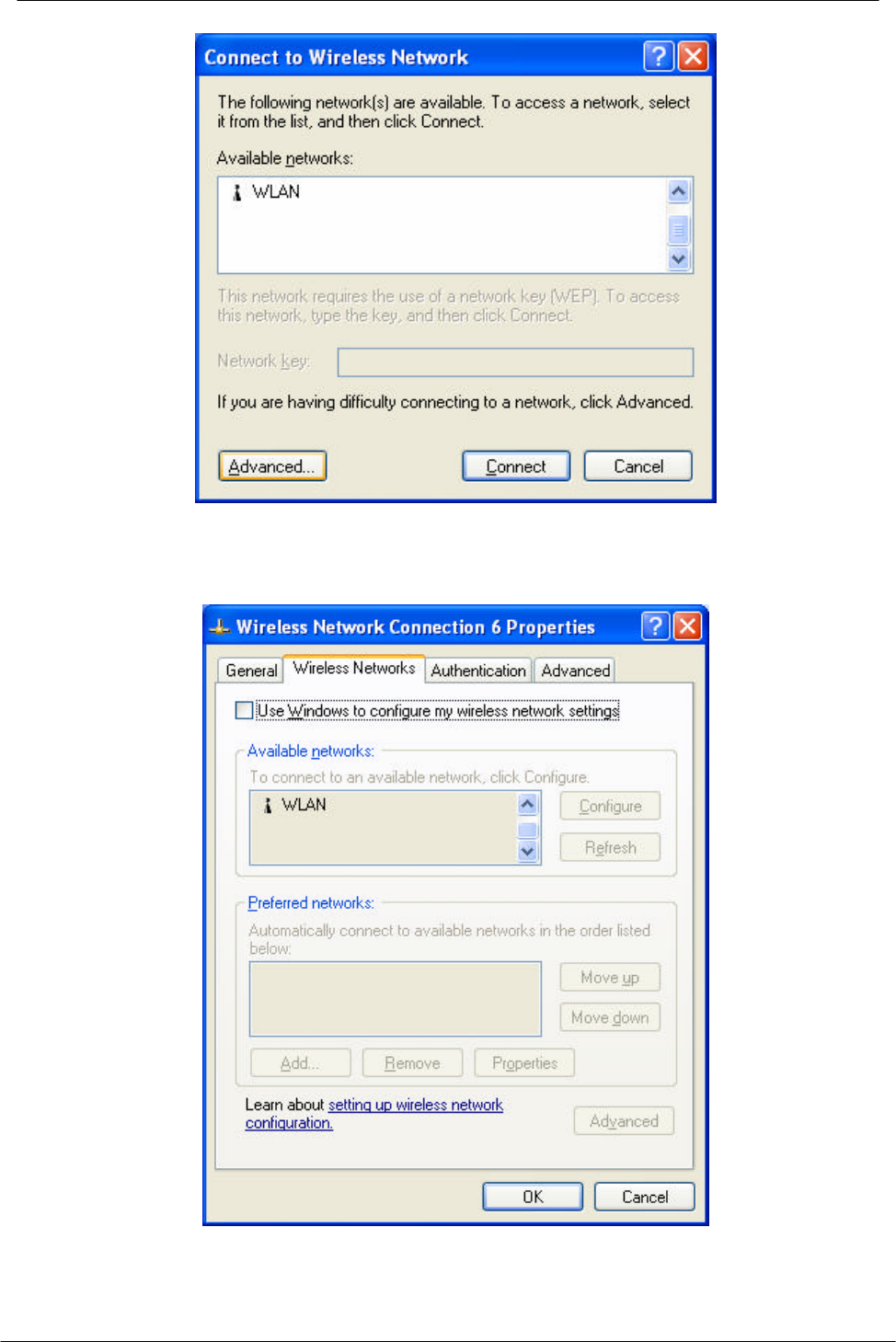
54M Wireless LAN CardBus Card User’s Manual
17
4. Make sure “Use Windows to configure my wireless network settings” is unchecked
and click OK button.
5. Click Start -> All Programs -> IEEE802.11a/g WLAN CardBus Card then click
IEEE802.11a/g WLAN CardBus Card Utility to restart IEEE802.11a/g WLAN Card.
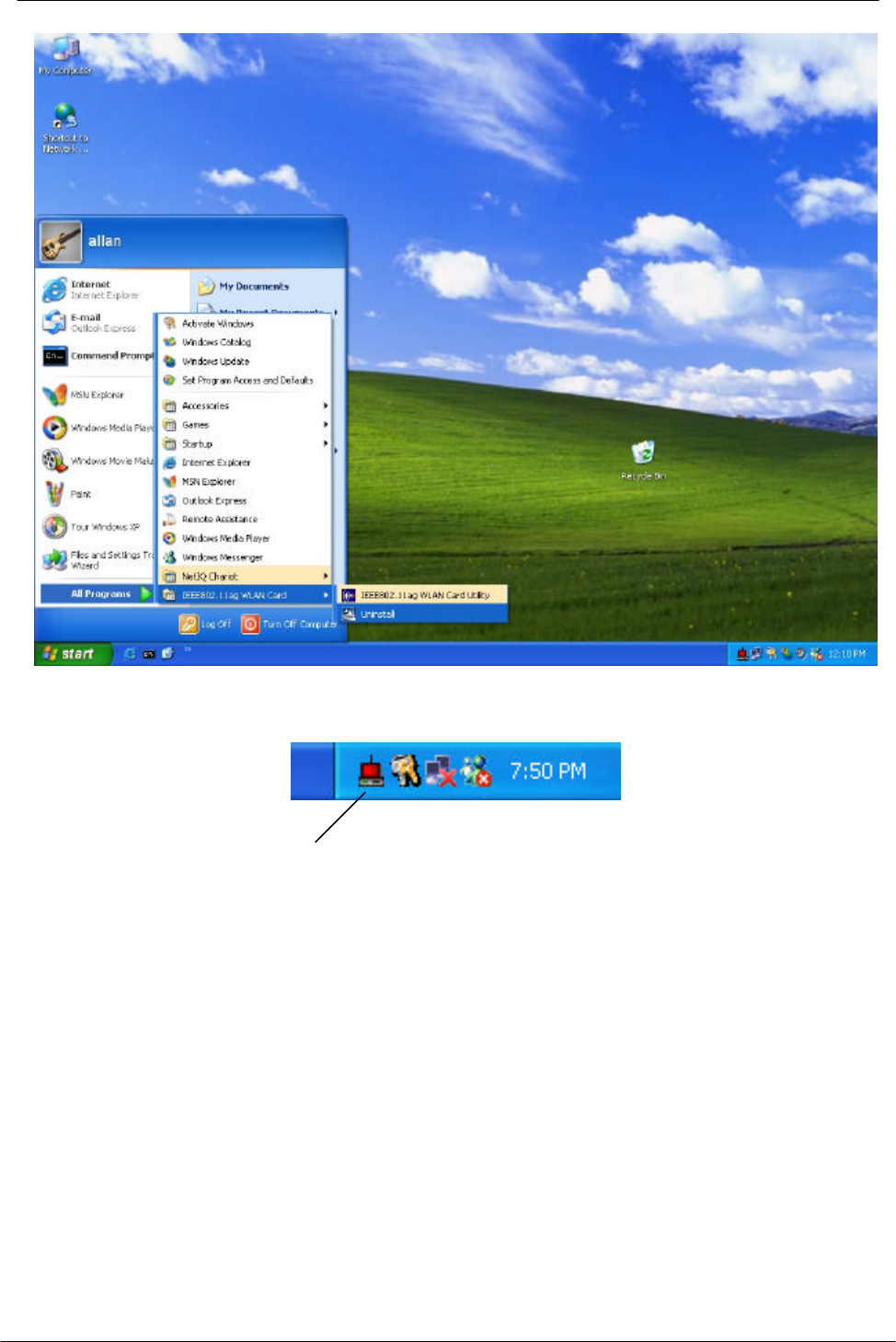
54M Wireless LAN CardBus Card User’s Manual
18
6. The Wireless LAN Utility will appear, Double-click the icon to open the
configuration utility.
Wireless LAN Utility
7. Click Re-Scan button to start Wireless LAN Utility. (Refer to Configuring the
CardBus Wireless LAN Card.)
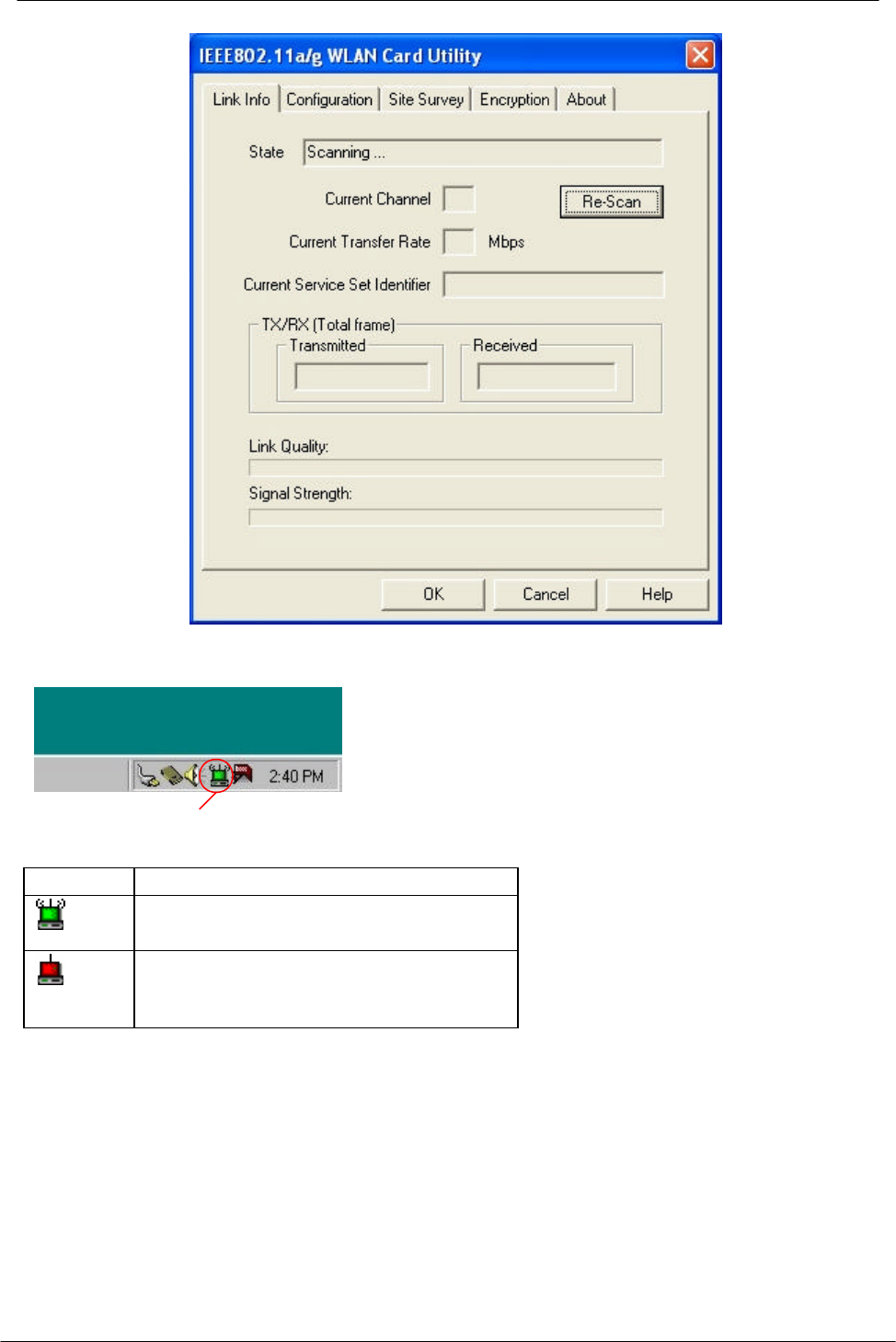
54M Wireless LAN CardBus Card User’s Manual
19
Use Wireless LAN Utility In Windows 98, 2000 and ME
Wireless LAN Utility icon
Icon Meaning
Green: indicates a connection is linked
to a wireless network.
Red: indicates that the wireless LAN
card is looking for an available access
point.
Double-click the icon to open the Wireless LAN Utility. (Refer to Configuring the
CardBus Wireless LAN Card.)
Configuring the CardBus Wireless LAN Card
1. This screen shows you the status of your current connection. Click Re-Scan to
search for wireless connection (the adapter will search for the connection
automatically when it is activated).
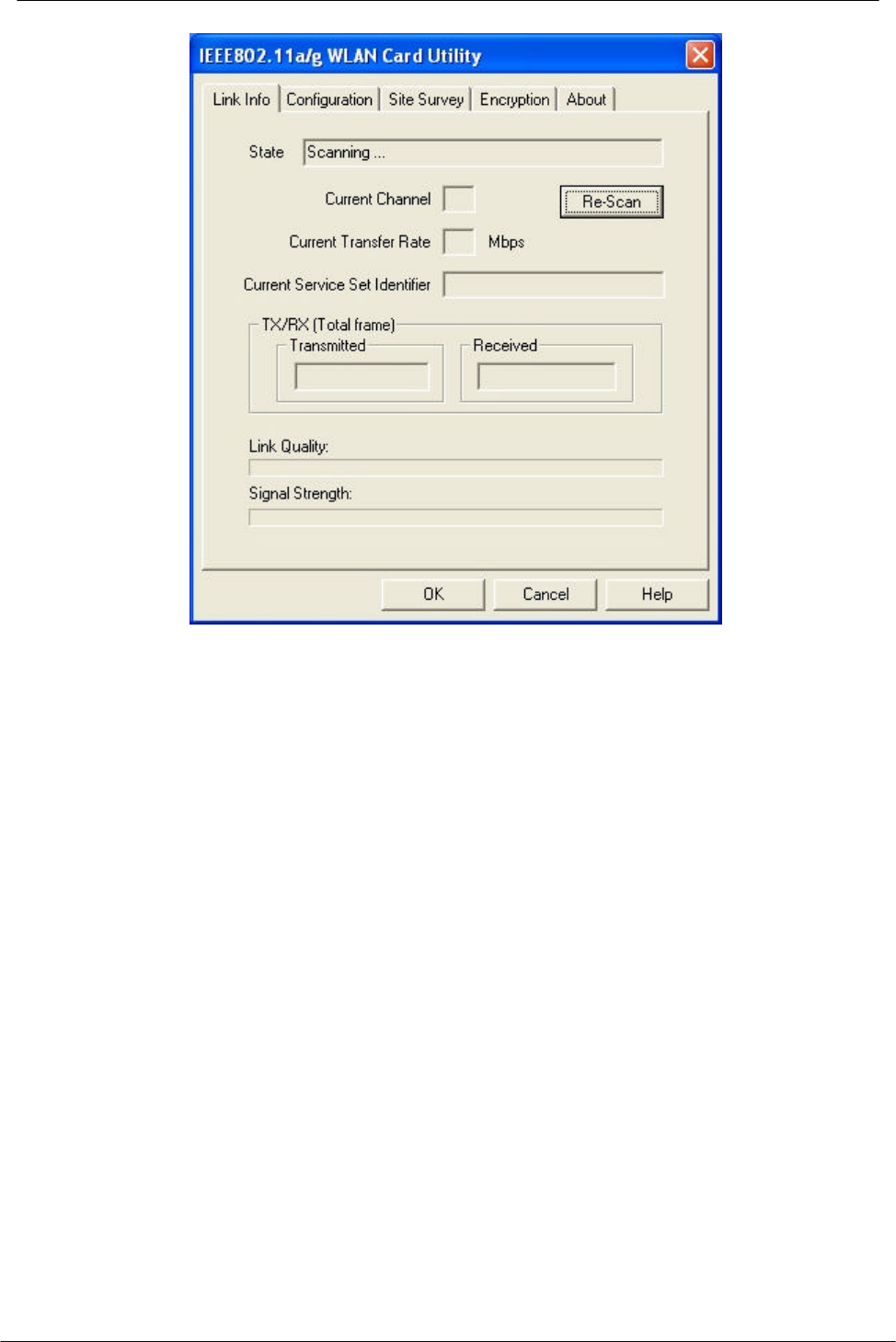
54M Wireless LAN CardBus Card User’s Manual
20
2. Select the “Configuration” tab. The profile setting allows you to save
configurations in different profiles for different working environments. The default
profile will contain the initial configuration setting when you install the Card. Under
the Operating Mode drop-box, you may choose either Infrastructure or Ad-Hoc.
The Infrastructure mode allows a wireless adapter to communicate with a wired
network employing an Access Point, while the Ad-Hoc mode allows
wireless-to-wireless, peer-to-peer communication. If you choose Infrastructure, the
SSID should have the same name as the Access Point. If you choose Ad-Hoc, all
clients should share the same SSID name. You can select Enabled Power Saving
Mode to allow your adapter to go to sleep mode while the adapter doesn’t precede
the data transmission. Or select Disabled to make the adapter never go to sleep
mode. Click Apply to save the settings.
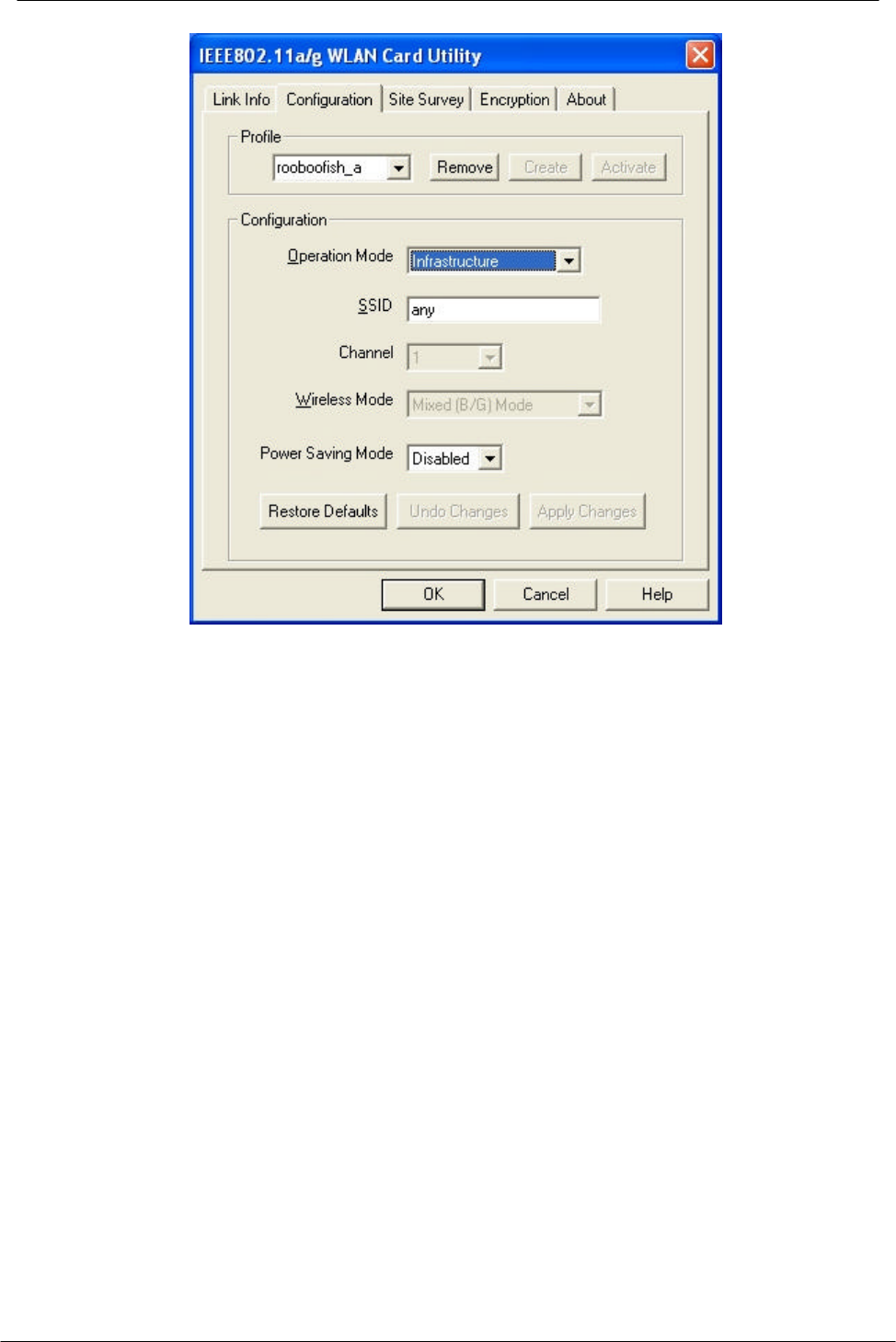
54M Wireless LAN CardBus Card User’s Manual
21
3. Select the “Site Survey” tab. The list on the adjacent screen shows you available
Access Points and their features. Click on the desired Access Point, and then click
Connect to connect or Search to search for more Access Points. Click OK when
you are finished.
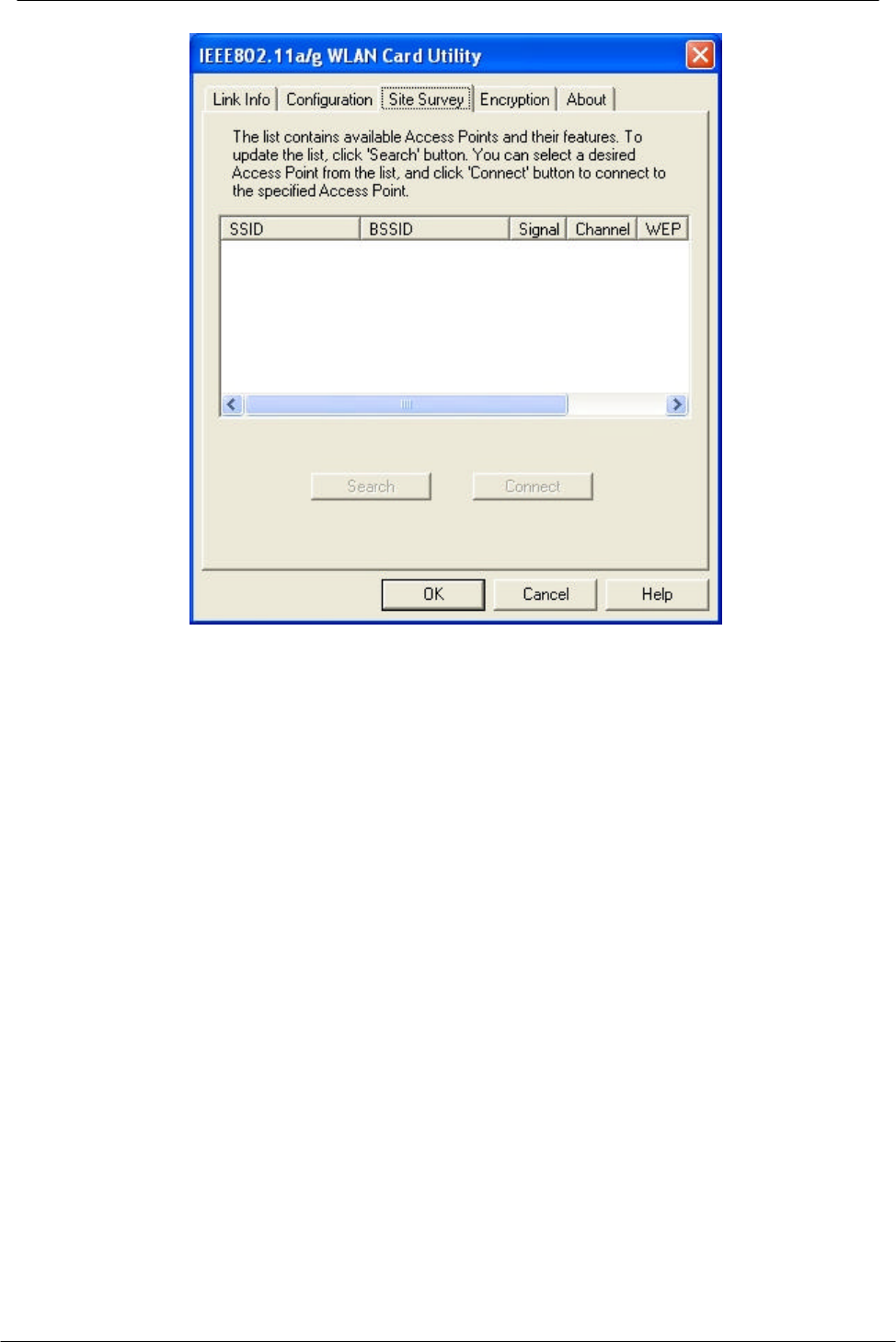
54M Wireless LAN CardBus Card User’s Manual
22
4. Click on the “Encryption” tab. Under the drop-box, you can choose to have WEP
encryption Disabled, 64-Bit, or 128-Bit. Wired Equivalent Privacy (WEP) is an
encryption scheme used to protect wireless data communication. The Disabled
setting prevents the sharing of data with other computers on the WEP network. For
data sharing to be enabled, select the level of encryption desired, either 64 or
128-bit.
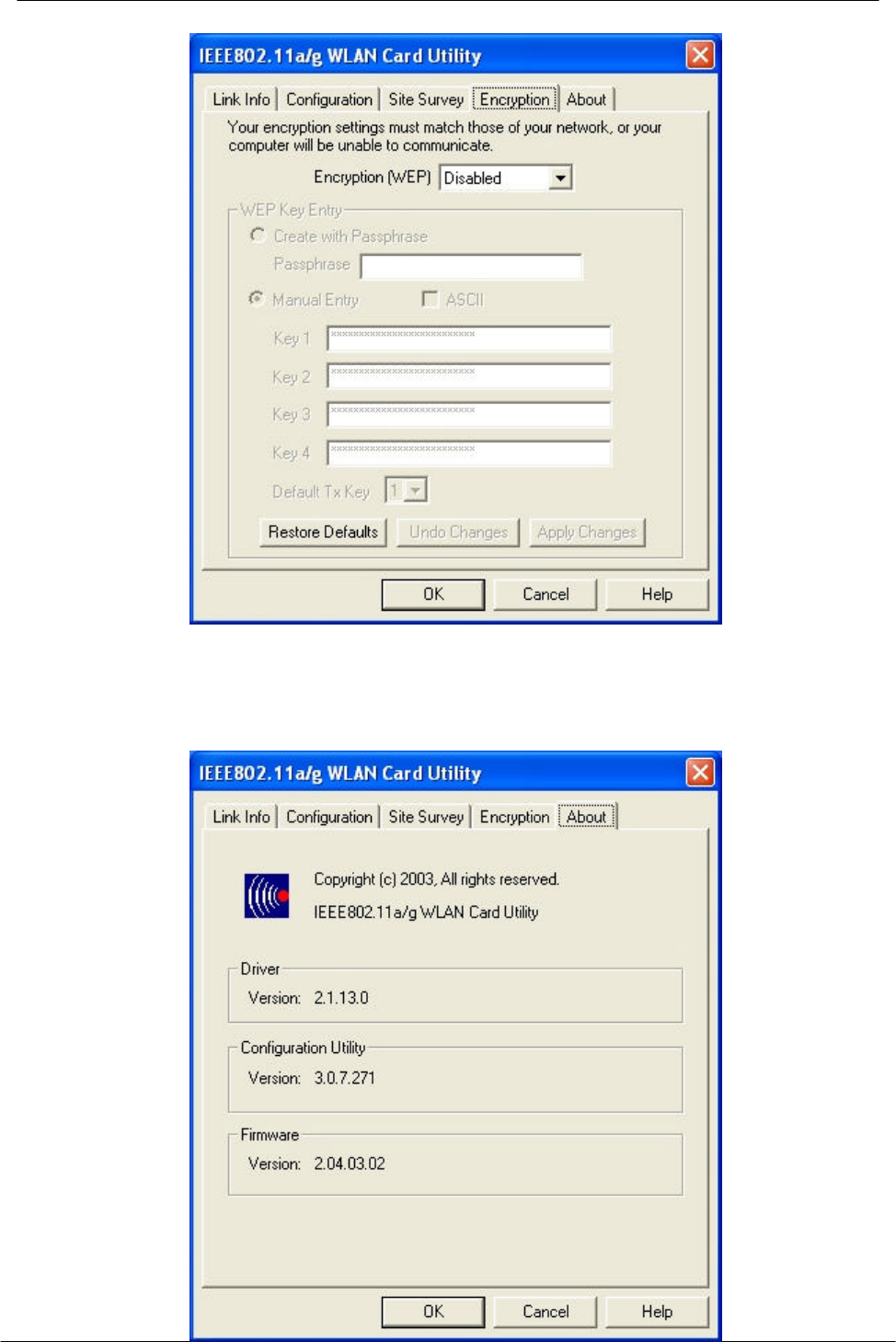
54M Wireless LAN CardBus Card User’s Manual
23
5. The “About” tab shows you copyright and version information about the driver, the
configuration utility, and the firmware. Click OK to complete the configuration.

54M Wireless LAN CardBus Card User’s Manual
24